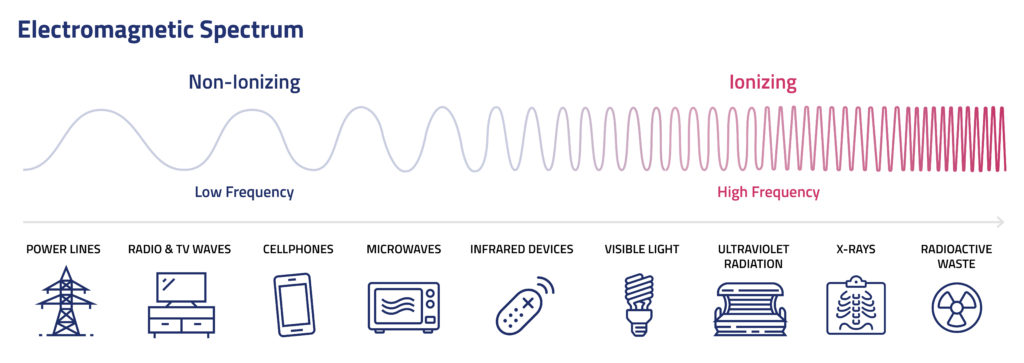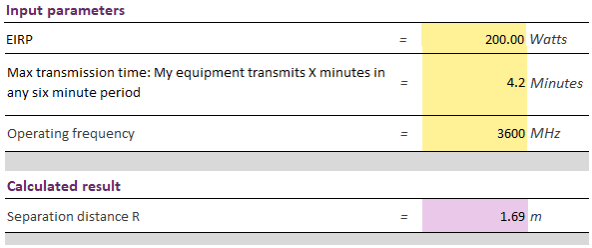Many concerns have been raised over the years when it comes to the safety of electric and magnetic field (EMF) exposure to the human body. Yet, we are all used to the electronic conveniences of modern life. Giving up any of these technologies would call for a drastic change in our way of life. For example, with a network outage, businesses are not able to process orders or collect payments; individuals are not able to access their emails or get connected with their friend living halfway around the world.
Needless to say, life with electronics is here to stay. But how safe are we from EMF radiation, or more specifically in this article, radio frequency waves? Can BLiNQ’s eNB system be installed in a residential area without causing bodily harm?
EMF Explained
EMF can be found occurring everywhere around us, either naturally or artificially. They are grouped into one of two categories based on their frequency:
- Non-ionizing: low-level radiation which is generally perceived as harmless to humans.
- Ionizing: high-level radiation which has the potential for cellular and DNA damage.

As you can see from Figure 1 above, radio frequency waves fall under the non-ionizing, low-level radiation side of the spectrum.
What is Radio Frequency?
Radio frequency (RF) is a measurement representing the oscillation rate of electromagnetic radio waves from frequencies ranging from 300 gigahertz (GHz) to as low as 3 kilohertz (kHz).
The International Telecommunication Union (ITU), based in Geneva, Switzerland, divides the radio spectrum into 12 bands that ranges from Extremely Low Frequency (3 – 30 Hz) to Tremendously High Frequency/Terahertz (300 – 3000 GHz).
Each band begins at a wavelength which is a power of ten (10n) metres, with corresponding frequency of 3 x108-n hertz, and each covering a decade of frequency or wavelength.
The specific biological response to RF fields is related to rate of energy absorbed or strength of RF waves generated. As per studies done, below 10kHz, RF energy can induce internal electric fields (nerve stimulation) while between 100kHz and 300GHz, tissue heating can occur. Between 10kHz and 100kHz, it could induce both nerve stimulation and tissue heating.
- For nerve stimulation/internal electric fields generation concerns, safety/regulatory agencies such as the FCC or Health Canada, use internal electric field strength V/m thresholds to determine safe exposure levels.
- For tissue heating concerns, safety/regulatory testing agencies (such as Nemko) use whole body SAR (Specific Absorption Rate) as the measure to determine safe thresholds – Watts/kg.
- When the frequency is above 6 GHz, RF energy absorption occurs on the surface tissues and the use of SAR limits will not be accurate or appropriate. In such cases, power density (W/m2) is the appropriate exposure matrix.
Based on the safe thresholds determined by these agencies, proper formulas and calculations have been devised and adhered to by the industry worldwide. The RF safety exposure distance calculation available on the two sites below follow the safety thresholds set by the ITU and other governing bodies:
- http://arrl.org/rf-exposure-calculator (National Association of Amateur Radio)
- https://static.ofcom.org.uk/static/emf/index.html#/ (Ofcom)
Safe Thresholds for BLiNQ Radios
All of BLiNQ’s radios have been rigorously tested and certified by different regional regulatory agencies such as the FCC. We conduct these evaluations using the compliance rules and guidelines adopted by both the FCC and Industry Canada. They are based on the results of the Maximum Permissible Exposure (MPE) studies by the FCC for mobile or fixed devices, which dictate MPE limits for human exposure to RF energy.
When used as intended, BLiNQ wireless networking devices do not pose health risks. Like other devices that emit RF energy (such as computers and microwave ovens), the level of RF emissions is too low to cause harm when the RF Safety minimum distance is kept.
To calculate the safe distance for a FW-300i operating in CBRS band (3550-3770 MHz) using the AARL calculator:

- Power at Antenna: 4W (36 dBm combined MIMO Tx power)
- Mode duty cycle: Carrier always On, 100% duty cycle
- Transmit duty cycle:
- For 2-7 TDD configuration: 7 minutes transmit; 3 minutes receive (70% transmission time)
- For 1-7 TDD configuration: 1 minutes transmit; 1 minute receive (50% transmission time)
- Antenna Gain: 17 dBi
- Operating Frequency: 3600 MHz
Similarly, using the OFCOM (UK) calculator (Excel version):

- EIRP: 200 Watts (53 dBm made up of 36 dBm Tx power plus 17 dBi antenna gain)
- Max. Transmission time:
- For 2-7 TDD configuration: 4.2 minutes (70% transmission time)
- For 1-7 TDD configuration: 3 minutes (50% transmission time)
- Antenna Gain: 17 dBi
- Operating Frequency: 3600 MHz
In both calculations, we have come to the same conclusion of 5.5 ft (1.69 m) as the minimum safety distance in the TDD 2-7 configuration and 4.7 ft (1.42m) in 1-7 TDD configuration.
The safety distances for BLiNQ’s radios are listed in their respective user guides. It is up to each operator to adhere to the safety distances listed when installing and configuring the radio system to prevent unnecessary exposure to RF energy.
As you can see (and verify), installing a BLiNQ radio in a residential or high traffic area according to the safety guidelines does not pose any danger to the human body. Whether you are an operator looking to expand network or an individual thinking about joining the De-Wi sphere, our eNBs can provide a safe and reliable connection.
While we cannot avoid RF radiation in our modern, electrical, technological world, we could do our best in protecting ourselves and be more knowledgeable about what we are exposed to.
For more information about BLiNQ’s radios, please contact info@blinqnetworks.com.
To purchase BLiNQ products online, head over to our web store.
Useful Links:
- Nemko (Testing, Inspection, and Certification Services) – https://www.nemko.com/
- FCC: RF Safety FAQ – https://www.fcc.gov/engineering-technology/electromagnetic-compatibility-division/radio-frequency-safety/faq/rf-safety
- Canada.ca: Limits of Human Exposure to Radiofrequency Electromagnetic Energy in the Frequency Range from 3 kHz to 300 GHz – https://www.canada.ca/en/health-canada/services/publications/health-risks-safety/limits-human-exposure-radiofrequency-electromagnetic-energy-range-3-300.html
Sources:
- Should You Be Worried About EMF Exposure? – https://www.healthline.com/health/emf#research
- Electromagnetic Fields and Cancer – https://www.cancer.gov/about-cancer/causes-prevention/risk/radiation/electromagnetic-fields-fact-sheet
- Electric & Magnetic Fields – https://www.niehs.nih.gov/health/topics/agents/emf/index.cfm
- RF Safety FAQ – https://www.fcc.gov/engineering-technology/electromagnetic-compatibility-division/radio-frequency-safety/faq/rf-safety
- Wikipedia: Radio Spectrum – https://en.wikipedia.org/wiki/Radio_spectrum